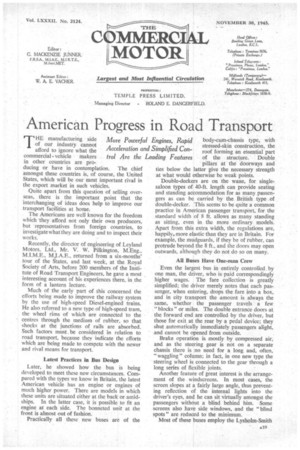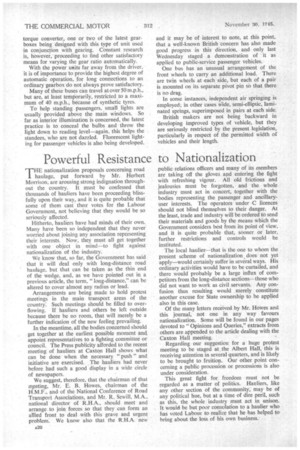American Progress in Road Transport
Page 21

Page 22

If you've noticed an error in this article please click here to report it so we can fix it.
THE manufacturing side of our industry cannot afford to ignore what the commercial vehicle makers in other countries are producing or have in contemplation. The chief amongst these countries is, of course, the United States, which will be our most important rival in the export market in such vehicles.
Quite apart from this question of selling overseas, there is the important point that the interchanging of ideas does help to improve our transport facilities at home.
The Americans are well known for the freedom which they afford not only their own producers, but representatives from foreign countries, to investigate what they are doing and to inspect their works.
Recently, the director of engineering of Leyland Motors, Ltd., Mr. V. W. Pilkington, M.Eng., M.I.M.E., MJ.A.E., returned from a six-months' tour of the States, and last week, at the Royal Society of Arts, before 200 members of the Institute of Road Transport Engineers, he gave a most interesting account of his experiences there, in the form of a lantern lecture.
Much of the early part of this concerned the efforts being made to improve the railway system by the use of high-speed Diesel-engined trains. lie also referred to a new type of high-speed tram, the wheel rims of which are connected to the centres through the medium of rubber, so that shocks at the junctions of rails are absorbed. Such factors must. be considered in relation to road transport, because they indicate the efforts which are being made to compete with the newer and rival means for transport.
Latest Practices in Bus Design Later, he showed how the bus is being developed to meet these new circumstances. Compared with the types we know in Britain, the latest American vehicle has an engine or engines of much higher power. There are models in which these units are situated either at the back or. amidships. In the latter case, it is possible to fit an engine at each side. The bonneted unit at the front is almost out of fashion.
Practically all these new buses are of the body-cum-chassis type, with stressed-skin construction, the roof forming an essential part of the structure. Double pillars at the doorways and ties below the latter give the necessary strength at what would otherwise be weak points.
Double-deckers are on the wane, for singlesaloon types of 40-ft. length can provide seating and standing accommodation for as many passengers as can be carried by the British type of double-decker. This seems to be quite a common practice in American passenger transport, for the standard width of 8 ft. allows as many standing as sitting, even in the more ordinary models. Apart from this extra width, the regulations are, happily more elastic than they are in Britain. For example, the mudguards, if they be of rubber, can protrude beyond the 8 ft., and the doors may open outwards, although they do not do so on many.
All Buses Have One-man Crew Even the largest bus in entirely controlled by one man, the driver, who is paid correspondingly higher wages. The fare collection is greatly simplified; the driver merely notes that each passenger, when entering, drops the fare into a box, and in city transport the amount is always the same, whether the passenger travels a few "blocks" or miles. The double entrance doors at the forward end are controlled by the driver, but those for exit at the rear by a pedal device; they shut automatically immediately passengers alight, • and cannot be opened from outside.
Brake operation is mostly by compressed air, and as the steering gear is not on a separate chassis there is no need for a long and, often, " waggling " column; in fact, in one new type the steering wheel is connected to the gear through a long series of flexible joints.
Another feature of great interest is the arrangement of the windscreens. In most cases, the screen slopes at a fairly large angle, thus preventing reflection of the internal lights into the driver's eyes, and he can sit virtually amongst the passengers without a blind behind him. Some screens also have side windows, and the "blind spots" are reduced to the minimum.
Most of these buses employ the LyshOlni-Smith Al0 torque converter, one or two of the latest gearboxes being designed with this type of unit used in conjunction with gearing. Constant research is, however, proceeding to find other satisfactory means for varying the gear ratio automatically.
With the power units far away from the driver, it is of importance to provide the highest degree of automatic operation, for long connections to an ordinary gearbox do not always prove satisfactory.
Many of these buses can travel at over 50 m.p.h., but are, at least temporarily, restricted to a maximum of 40 m.p.h., because of synthetic tyres.
To help standing passengers, small lights are usually provided above the main windows. So far as interior illumination is concerned, the latest practice is to conceal the bulbs and throw the light down to reading level—again, this helps the standees, who are not dazzled. Fluorescent lighting for passenger vehicles is also being developed. and it may be of interest to note, at this point. that a well-known British concern has also made good progress in this direction, and only last Wednesday staged a demonstration of it as applied to public-service passenger vehicles.
One bus has an unusual arrangement of the front wheels to carry an additional load. There are twin wheels at each side, but each of a pair is mounted on its separate pivot pin so that there is no drag.
In some instances, independent air springing is employed; in other cases Wide, semi-elliptic, laminated springs, superimposed in pairs at each side.
British makers are not being backward in developing improved types of vehicle, but they are seriously restricted by the present legislation, particularly in respect of the permitted width of vehicles and their length.




























































